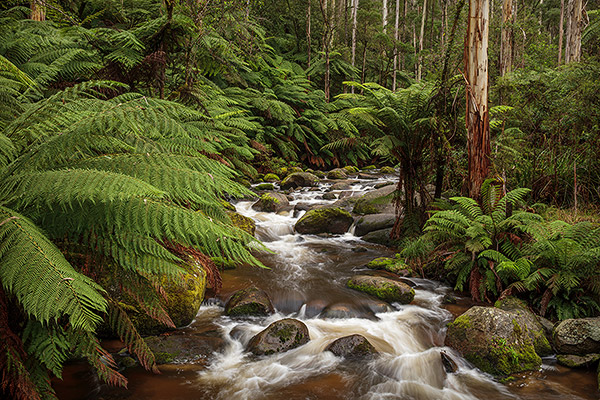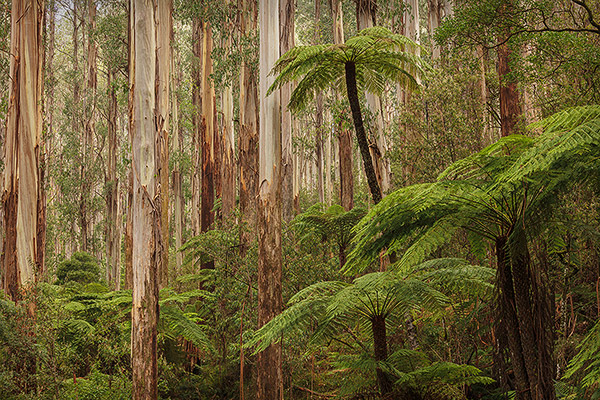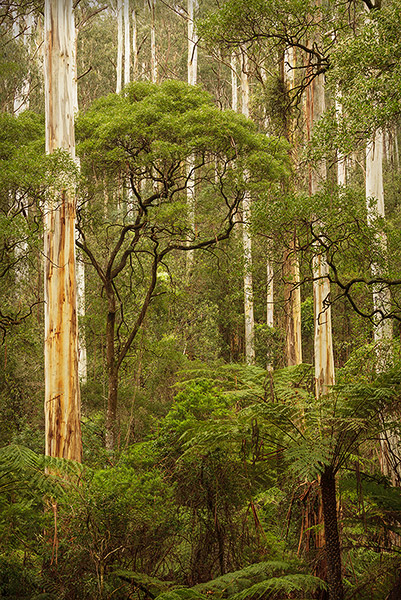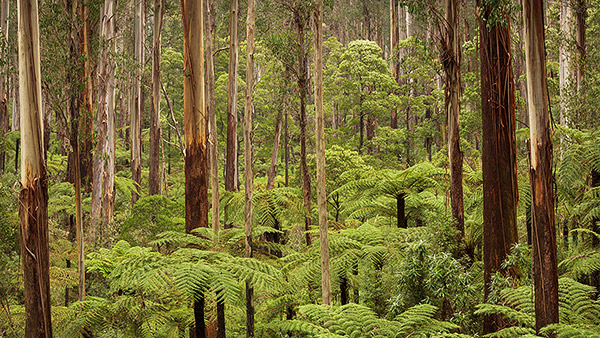Primeval Forest #1, Victoria, Australia
(Click image to enlarge)
Primeval Forest #2, Victoria, Australia
(Click image to enlarge)
Primeval Forest #3, Victoria, Australia
(Click image to enlarge)
Primeval Forest #4, Victoria, Australia
(Click image to enlarge)
The combination of towering trees, tree ferns, moss and dense ground level vegetation in Victoria's tall forests create a prehistoric, otherworldly, and enchanting atmosphere unlike any other that I have seen. I decided to create a series of photographs that attempt to show the essence of these rapidly disappearing places. The photographs can be viewed above, and on a page of larger images to which they link. If I find other appropriate images they will be added to this series in the future.
The predominant trees in this forest are mountain ash (eucalyptus regnans), known variously as mountain ash, swamp gum, or stringy gum. They are a broad-leaved, evergreen, hardwood tree that can reach heights of more than 114 meters (375 feet). Mountain ash trees are the world's tallest flowering plant and the second tallest trees on earth, next to North America's coast redwoods.
Historically, fires have not occurred often in this wet rainforest environment, but that is no longer true. Human caused climate change is creating more severe droughts more frequently, and today fire is a significant threat to these tall mountain ash forests. These trees are very sensitive to fire, and nearly all that are burnt are killed. Essential oils that give eucalyptus trees their fragrance are highly flammable. They also produce large quantities of flammable material in the leaf litter layer on the forest floor. The outer layer of bark on eucalyptus trees dies each year and peels away in very long and thin strands. The countless long strands, some of which are many meters in length, hang from the tree trunks, fall onto the forest floor, and hang from other vegetation. This makes it easy for a fire to get started and spread quickly, while the long, dry, and hanging bark strands quickly take fire high up into the canopy. This shed bark also forms burning embers that can be cast 30 kilometers (18 miles) ahead of a fire. Fires in Australia have been measured traveling up to 72 km/h (45 mph). Eucalyptus trees have some ability to re-sprout after a fire and their seeds often survive, but today's more frequent and intense fires severely limit the ability of these forests to regenerate.
Although these tall mountain ash forests can dominate a landscape for many hundreds of years, they are not the final stage of natural succession. In fact they are self extinguishing because mountain ash seedlings cannot survive in the shade created by a mature mountain ash forest. The final stage of natural succession in these regions is the myrtle beech forest. These shade tolerant trees take over as the mountain ash trees age and eventually die off. With a very low fire resistance and low tolerance for full sunlight, myrtle beech forests are often completely wiped out by fires, and the fire - mountain ash - myrtle beech cycle repeats.
The plants in some of these photographs that look like palm trees are not trees. They are true ferns, aptly called tree ferns. They reproduce from spores rather than seeds, and like all ferns they have a rhizome from which the fronds emerge. A tree fern is simply a fern in which rhizome is very long and strong enough to support itself. Their long arching fronds can reach 3 meters (9.8 feet) in length, and some of these ferns reach a height of up to 20 meters (66 feet). Large tree ferns can be more than 500 years old.
Logging has historically been far more damaging to these native forests than fire, having eliminated roughly 99% of them. Fortunately a landmark supreme court judgment in November of 2022 found that the state-owned logging agency, VicForests, has broken the law by failing to protect endangered species. With all of the appeals now finished and failed, all logging of Victoria's native forests will stop by the end of 2023. Since Australia's mountain ash forests have the highest biomass carbon density of any forest on earth, this court decision is beneficial for both our climate and the forests, not to mention the diverse species of plants and animals that these forests protect.



